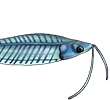Marinho, Y.F., Oliveira, C.Y.B., Mendes, L.E.M., Santos, I.R.A., Dias, J.A.R., Ândrade, M., Y.V.A. Lopes, Y.V.A., J.W.J. Azevedo, J.W.J., Lourenço, C.B., Moura, R.S.T. & F.P. Ottoni. (2024). Co-feeding using live food and feed as first feeding for the small catfish Trachelyopterus galeatus (Linnaeus 1766). Arq. Bras. Med. Vet. Zootec., 76(2), 323-332.
Marinho, Y.F., Oliveira, C.Y.B., Mendes, L.E.M., Santos, I.R.A., Dias, J.A.R., Ândrade, M., Y.V.A. Lopes, Y.V.A., J.W.J. Azevedo, J.W.J., Lourenço, C.B., Moura, R.S.T. & F.P. Ottoni. (2024). Coalimentação utilizando alimento vivo e ração na primeira alimentação do pequeno bagre Trachelyopterus galeatus (Linnaeus 1766). Arq. Bras. Med. Vet. Zootec., 76(2), 323-332.
Keywords: aquaculture, Artemia franciscana, Chaetoceros, larviculture, native fishThis study evaluated the effect of co-feeding with commercial feed and live food (enriched or not with microalgae) on the growth and survival of larvae. Five treatments were carried out: commercial feed as a control (F); brine shrimp nauplii (BS); brine shrimp nauplii enriched with Chaetoceros sp. Microalgae (BSM); combined feed with brine shrimp nauplii (F+BS) and combined feed with brine shrimp nauplii enriched with microalgae (FBSM). The larvae (5.00±0.02 mg and 5.95±0.33mm) were reared for 30 days. There were no significant differences (P>0.05) in water quality between treatments, but there were significant differences in weight, weight gain and survival. The F+BS and F+BSM treatments, which involved co-feeding, showed the best results in final weight (0.168±0.004g and 0.169±0.007g) and weight gain (0.1278±0.004 g and 0.1294±0.007g), respectively. The treatments with live food, enriched or not, showed high survival rates of over 73%, with no significant differences between them. On the other hand, the exclusive use of feed resulted in low survival (36.7 ± 9.53%), indicating that this may result in low growth and make the production of T. galeatus larvae unfeasible.
Palavras-chave: aquicultura, Artemia franciscana, Chaetoceros, larviculturas, peixe nativoRESUMO
Este estudo avaliou o efeito da coalimentação com ração comercial e alimentos vivos (enriquecidos ou não com microalgas) no crescimento e na sobrevivência das larvas de . Foram realizados cinco tratamentos: ração comercial como controle (F); náuplios de artêmia (BS); náuplios de artêmia enriquecidos com microalga Chaetoceros sp. (BSM); ração combinada com náuplios de artêmia (F+BS) e ração combinada com náuplios de artêmia enriquecidos com microalga (F+BSM). As larvas (5,00±0,02mg e 5,95±0,33mm) foram criadas por 30 dias. Não houve diferenças significativas (P>0,05) na qualidade da água entre os tratamentos, mas houve diferenças significativas no peso, no ganho de peso e na sobrevivência. Os tratamentos F+BS e F+BSM, que envolveram coalimentação, mostraram os melhores resultados em peso final (0,168±0,004g e 0,169±0,007g) e em ganho de peso (0,1278±0,004g e 0,1294±0,007g), respectivamente. Os tratamentos com alimentos vivos, enriquecidos ou não, mostraram altas taxas de sobrevivência acima de 73%, sem diferenças significativas entre eles. Por outro lado, o uso exclusivo de ração resultou em baixa sobrevivência (36,7±9,53%), indicando que isso pode resultar em baixo crescimento e inviabilizar a produção
de larvas de T. galeatus.





